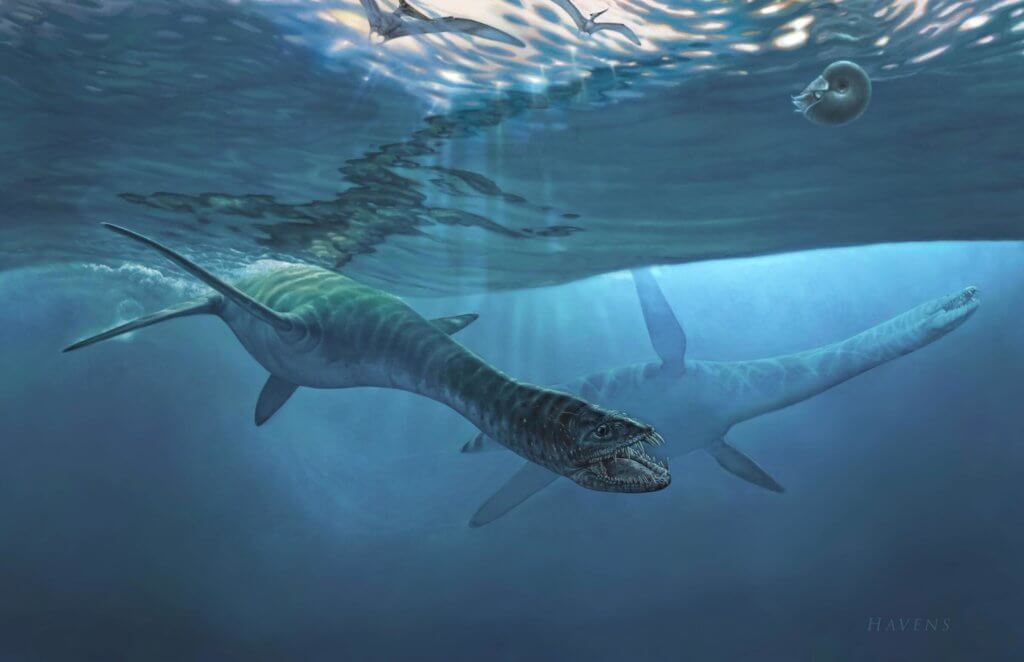Diving Deep with Nakonanectes bradti, a Lizard-Like Sea Dweller of the Past
by Suzanne Hendrich
Broadcast 11.24 & 11.27.2021

Artist’s rendition of Nakonanectes bradti. Illustration by James Havens, www.havensstudio.online.
Listen:
Imagine being on the shore of the Western Interior Seaway, 73 million years ago, near what is now Fort Peck Lake and the Charles M. Russell National Wildlife Refuge. (Yes, Montana once had beachfront property along a huge, warm, shallow inland sea!) You spy elasmosaurid Nakonanectes bradti as she comes up for air, showing teeth the size of a great white shark’s. She stretches her neck, longer than a giraffe’s, basking in the warm sea, savoring her latest catch, a tasty barracuda. Palm branches snap behind you. You feel the heavy steps of Deinosuchus on the prowl. Forty scary feet of crocodilian slides past you into the sea, eager to make a meal of either this skiff-long elasmosaurid or perhaps a sea turtle as wide as your patio table. You sigh in sweet relief as your time-transporter whisks you forward, before you too are prey to one of the awesome and wondrous reptiles of our past.
Envisioning life 73 million years ago, when Nakonanectes bradti lived, is the work of paleontologists, who have learned that Montana is a true treasure state for fossils. Montana fossils span a vast stretch of time. More than 350 million years ago, many small shellfish were abundant, such as those found in Mississippian Madison limestone near Drummond. Only 10,000 years ago, during the last Ice Age, the Columbian mammoth still roamed what is now an eastern Montana ranch.
As a retired professor of nutrition, one thing I was glad to confirm in my new life, moving from Ames, Iowa, to Missoula, Montana, in early 2018, was that, more than anything, I love learning. I explore fields of science that I know little about through online courses: geology, astronomy, ancient marine reptiles. Dinosaurs capture every child’s sense of wonderment and awe, a way of approaching life that I want to keep practicing. But those ancient, mostly land-dwelling reptiles represent only part of the fauna of ancient times. They had marine counterparts, air-breathing sea-dwellers of three main classes: ichthyosaurs (fish-like), mosasaurs (whale-shaped), and sauropterygians (varied lizard-like sea dwellers). It seems that my move to Montana was fortuitous because Montana is a great site for marine reptile fossils. This includes one of the most spectacular, because of its completeness—a type of sauropterygian, the elasmosaurid Nakonanectes bradti.
Imagine having a fossil named after you! David Bradt from Florence, Montana, discovered this fossil on an elk hunting trip through the Bearpaw Shale in the Russell Refuge in 2010. He found the fossil skull and neck bones lying at his feet in a remote, dry, creek bed. Paleontologists Danielle Serratos, Pat Druckenmiller and Roger Benson excavated and identified this fossil as a new type of elasmosaurid. Elasmosaurids had as many as 76 vertebrae, making their necks very long. Some of the creatures were as long as 50 feet. Their name means “thin-plated” because of their relatively thin chest and pelvis bones that resemble plates. Nakonanectes bradti seems long to me at her skiff-sized 18 feet, but it was actually one of the smallest and shortest-necked elasmosaurids. Nakononectes bradti is also named for the Nakona or Assiniboine Nation—Nakona, meaning “friendly people,”—as the fossil was found on their traditional homeland.
There must be a great many more fossils to find in Montana. Ones from the Mesozoic Era, the age of the giant reptiles, spanning 252 to 66 million years ago, may be the most awesome, such as Tyrannosaurus rex, or little Nakonanectes bradti. Pondering Nakonanectes makes me ponder life’s purpose. Perhaps mine is showing others the importance of wonderment and awe. A sense of awe grounds me in gratitude. This makes me wonder (and wander!), always, so that things as ancient and mysterious as fossils can yield their deepest lesson: to love and respect this amazing Earth and all of its lifeforms.
Every week since 1991, Field Notes has inquired about Montana’s natural history. Field Notes are written by naturalists, students, and listeners about the puzzle-tree bark, eagle talons, woolly aphids, and giant puffballs of Western, Central and Southwestern Montana and aired weekly on Montana Public Radio.
Click here to read and listen to more Field Notes. Field Notes is available as a podcast! Subscribe on iTunes, Google Play, or wherever you listen to podcasts.
Interested in writing a Field Note? Contact Allison De Jong, Field Notes editor, at adejong [at] montananaturalist [dot] org or 406.327.0405.
Want to learn more about our programs as well as fun natural history facts and seasonal phenology? Sign up for our e-newsletter! You can also become a member and get discounts on our programs as well as free reciprocal admission to 300+ science centers in North America!












